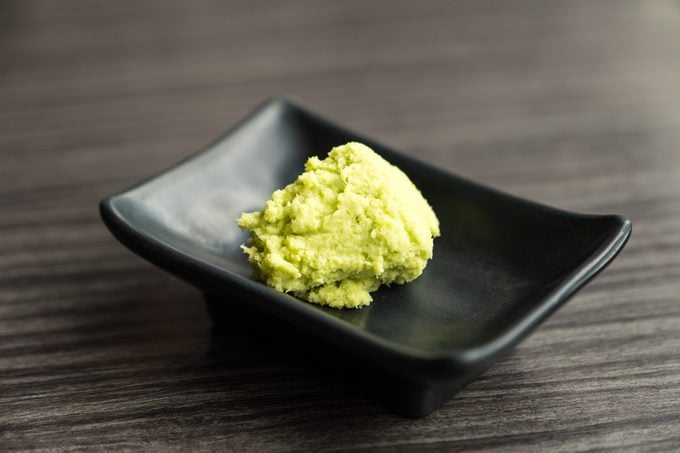The “Wasabi” You Get in Asian Restaurants Isn’t Really Wasabi
Updated: Apr. 04, 2021
Here's what that green paste that comes with your sushi is really made of.

It sits on most plates of sushi, tempting diners to spice up their meals, literally. Maybe you swirl it into your soy sauce. Maybe you just leave it be. Or maybe you’ve heard (or even bore witness to) a harrowing tale of an unknowing soul taking a big, painful bite of it without knowing what it was. Yes, we’re talking about wasabi—or are we?
Despite the fact that the majority of consumers call it “wasabi,” the green paste that comes with sushi almost never contains any actual wasabi. In an overwhelming majority of cases, it’s nothing but embellished horseradish. Horseradish mixed with mustard extract and citric acid, to be precise. As for the green color? It comes from green food dye. Find out some more surprising things you had no idea you were eating.
This widespread “fake wasabi” is created as an alternative to wasabi, but it’s actually pretty different from the real thing. Authentic wasabi actually comes from a Japanese herbal root that’s very rare and difficult to harvest. Those factors, combined with a high demand for it (especially in Japan), make even small amounts of it very pricey, which is the reason it’s not actually a sushi-restaurant staple. It’s so rare and costly that restaurants could never get away with plopping it on all of their sushi platters, and certainly not free of charge. According to the Washington Post, this wasabi alternative has been in the culinary mainstream, combatting the challenges presented by real wasabi, for many years—even before sushi gained such massive popularity in the United States. Plus, get to the bottom of another sushi mystery: What is imitation crab meat?
And this isn’t just true in the United States. Even in Japan, authentic wasabi is hard to come by. Trevor Corson, the author of The Story of Sushi, claims that even in Japan, real wasabi is hard to find. And when you do find it, it won’t be sitting on your plate like the horseradish concoction does. Instead, sushi chefs tuck it inside the sushi rolls. So, love it or hate it, the “wasabi” that you’re getting in Asian restaurants really isn’t at all authentic. But hey—that doesn’t mean it won’t continue to add a fun kick to your California roll. Next, find out some more secrets food manufacturers aren’t telling you.
